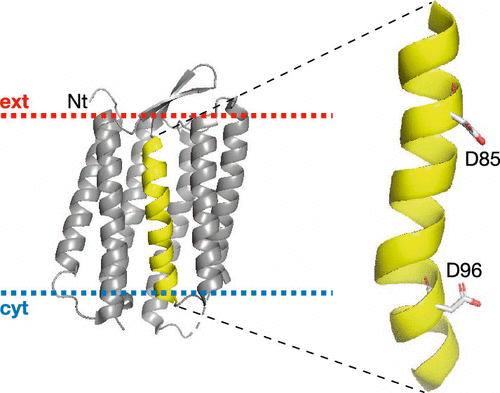Our official English website, www.x-mol.net, welcomes your
feedback! (Note: you will need to create a separate account there.)
Insertion of Bacteriorhodopsin Helix C Variants into Biological Membranes.
ACS Omega ( IF 3.7 ) Pub Date : 2019-12-31 , DOI: 10.1021/acsomega.9b03126 Manuel Bañó-Polo 1 , Luis Martínez-Gil 1 , Francisco N Barrera 2 , Ismael Mingarro 1
ACS Omega ( IF 3.7 ) Pub Date : 2019-12-31 , DOI: 10.1021/acsomega.9b03126 Manuel Bañó-Polo 1 , Luis Martínez-Gil 1 , Francisco N Barrera 2 , Ismael Mingarro 1
Affiliation

|
A peptide corresponding to bacteriorhodopsin (bR) helix C, later named pHLIP, inserts across lipid bilayers as a monomeric α-helix at acidic pH, but is an unstructured surface-bound monomer at neutral pH. As a result of such pH-responsiveness, pHLIP targets acidic tumors and has been used as a vehicle for imaging and drug-delivery cargoes. To gain insights about the insertion of bR helix C into biological membranes, we replaced two key aspartic residues that control the topological transition from the aqueous phase into a lipid bilayer. Here, we used an in vitro transcription-translation system to study the translocon-mediated insertion of helix C-derived segments into rough microsomes. Our data provide the first quantitative biological understanding of this effect. Interestingly, replacing the aspartic residues by glutamic residues does not significantly alters the insertion propensity, while replacement by alanines promotes a transmembrane orientation. These results are consistent with mutational data obtained in synthetic liposomes by manipulating pH conditions. Our findings support the notion that the translocon facilitates topogenesis under physiological pH conditions.
中文翻译:

细菌视紫红质螺旋C变种插入生物膜。
对应于细菌视紫红质(bR)螺旋C的肽(后来称为pHLIP)在酸性pH下作为单体α-螺旋插入脂质双层,但在中性pH下是未结构化的表面结合单体。由于这种pH响应性,pHLIP靶向酸性肿瘤,并已被用作成像和药物递送货物的载体。为了获得有关将bR螺旋C插入生物膜的见解,我们替换了两个关键的天冬氨酸残基,这些残基控制从水相到脂质双层的拓扑转变。在这里,我们使用了体外转录-翻译系统来研究螺旋C衍生片段的转录启动子介导的插入粗糙的微粒体。我们的数据提供了对此效应的第一个定量生物学理解。有趣的是 用谷氨酸残基替代天冬氨酸残基不会显着改变插入倾向,而用丙氨酸替代可促进跨膜取向。这些结果与通过控制pH条件在合成脂质体中获得的突变数据一致。我们的发现支持在生理pH条件下translocon促进拓扑发生的观点。
更新日期:2020-01-14
中文翻译:

细菌视紫红质螺旋C变种插入生物膜。
对应于细菌视紫红质(bR)螺旋C的肽(后来称为pHLIP)在酸性pH下作为单体α-螺旋插入脂质双层,但在中性pH下是未结构化的表面结合单体。由于这种pH响应性,pHLIP靶向酸性肿瘤,并已被用作成像和药物递送货物的载体。为了获得有关将bR螺旋C插入生物膜的见解,我们替换了两个关键的天冬氨酸残基,这些残基控制从水相到脂质双层的拓扑转变。在这里,我们使用了体外转录-翻译系统来研究螺旋C衍生片段的转录启动子介导的插入粗糙的微粒体。我们的数据提供了对此效应的第一个定量生物学理解。有趣的是 用谷氨酸残基替代天冬氨酸残基不会显着改变插入倾向,而用丙氨酸替代可促进跨膜取向。这些结果与通过控制pH条件在合成脂质体中获得的突变数据一致。我们的发现支持在生理pH条件下translocon促进拓扑发生的观点。











































 京公网安备 11010802027423号
京公网安备 11010802027423号